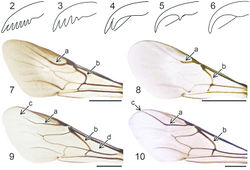Pseudospinolia
| Notice: | This page is derived from the original publication listed below, whose author(s) should always be credited. Further contributors may edit and improve the content of this page and, consequently, need to be credited as well (see page history). Any assessment of factual correctness requires a careful review of the original article as well as of subsequent contributions.
If you are uncertain whether your planned contribution is correct or not, we suggest that you use the associated discussion page instead of editing the page directly. This page should be cited as follows (rationale):
Citation formats to copy and paste
BibTeX: @article{Paukkunen2015ZooKeys, RIS/ Endnote: TY - JOUR Wikipedia/ Citizendium: <ref name="Paukkunen2015ZooKeys">{{Citation See also the citation download page at the journal. |
Ordo: Hymenoptera
Familia: Chrysididae
Name
Pseudospinolia Linsenmaier, 1951 – Wikispecies link – Pensoft Profile
- Pseudospinolia Linsenmaier, 1951: 31.
Note
This taxon has been treated as a subgenus of Euchroeus Latreille or Spinolia Dahlbom by some authors (Linsenmaier 1959[1], Morgan 1984[2], Arens 2014[3]). We follow the classification of Kimsey and Bohart (1991)[4] and regard it as a distinct genus. Characteristic morphological features include the broadly open marginal cell (Fig. 9), the edentate T3, the deep and subdivided depression laterally on the pronotum, and the elongate transverse frontal carina connecting the compound eyes. Members of the genus parasitise solitary vespids of the subfamily Eumeninae (e.g. Odynerus Latreille). Approximately 15 species are recognised worldwide, most of which occur in the Palearctic Region, particularly in the Middle East and the Mediterranean region (Kimsey and Bohart 1991[4]). The European fauna consists of eight species (Rosa and Soon 2012[5]), and one, Pseudospinolia neglecta, is found in the Nordic and Baltic countries (Paukkunen et al. 2014[6]).
Taxon Treatment
- Paukkunen, J; Berg, A; Soon, V; Ødegaard, F; Rosa, P; 2015: An illustrated key to the cuckoo wasps (Hymenoptera, Chrysididae) of the Nordic and Baltic countries, with description of a new species ZooKeys, (548): 1-116. doi
Images
|
Other References
- ↑ Linsenmaier W (1959) Revision der Familie Chrysididae (Hymenoptera) mit besonderer Brücksichtigung der europäischen Spezies. Mitteilungen der Schweizerischen Entomologischen Gesellschaft 32: 1–232.
- ↑ Morgan D (1984) Cuckoo-wasps, Hymenoptera, Chrysididae. Handbooks for the Identification of British Insects, Vol. 6, Part 5. Royal Entomological Society of London, London, 37 pp.
- ↑ Arens W (2014) Die Goldwespen der Peloponnes (Hymenoptera: Chrysididae) 1. Teil: Die Gattungen Cleptes, Omalus, Holopyga, Hedychrum, Hedychridium und Euchroeus; mit Beschreibung einer neuen Cleptes-Art. Linzer biologische Beiträge 46: 553–621.
- ↑ 4.0 4.1 Kimsey L, Bohart R (1991) [1990] The Chrysidid Wasps of the World. Oxford Press, New York, 652 pp.
- ↑ Rosa P, Soon V (2012) Fauna Europaea: Chrysididae. In: Mitroiu M (Ed.) Fauna Europaea: Hymenoptera, version 2.5. http://www.faunaeur.org [accessed 1 April 2015]
- ↑ Paukkunen J, Rosa P, Soon V, Johansson N, Ødegaard F (2014) Faunistic review of the cuckoo wasps of Fennoscandia, Denmark and the Baltic countries (Hymenoptera: Chrysididae). Zootaxa 3864: 1–67. doi: 10.11646/zootaxa.3864.1.1

